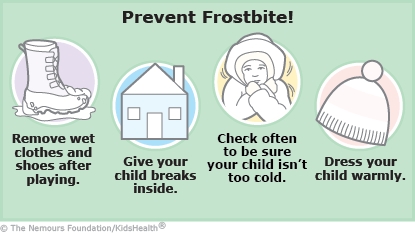Frostbite: How to Care for You Child
Frostbite is injury to the body due to cold exposure and can be dangerous. But with prompt care and rapid re-warming, most of these injuries heal well.


When out in the cold, the skin and tissues can get frozen.
Frostnip is the first sign that a person is too cold. The top layers of skin are too cold and the skin is red and tingly but still soft. Frostbite happens if a person with frostnip doesn't warm up. Then the deeper layers of skin become frozen and the skin becomes white and hard. When frostbite is severe, deeper tissues like muscle and bone can become frozen. At temperatures below 20°F, it only takes minutes for exposed skin to become frostbitten.
Frostbite is common in kids, because they lose heat from their bodies more quickly than adults do. Also, kids are more likely to get wet while playing in snow and resist taking breaks while having fun.
The parts of the body that tend to get frostbite most often are the nose, chin, cheeks, ears, fingers, and toes. When skin is red and tingly, this is an early form of frostbite, called frost nip, and a warning to get warm. Frostbitten skin loses color and feeling and may be hard or waxy.
The treatment for frostbite is to warm the frozen skin and tissues rapidly. Usually this is done with warm blankets or by soaking the frozen body parts in warm water (if possible). Once thawed, the frostbitten areas might be swollen and painful and should be kept warm. A second freeze causes even worse injury.
Your child might have been prescribed anti-inflammatory medicine (like ibuprofen) to decrease damage to the tissues and treat pain. The affected areas may have been cleaned to prevent infection. If needed, a tetanus shot also was given to prevent infection. The health care provider might have done tests to see how severe your child's frostbite was.

-
Do not try to break any blisters your child may have.
-
Clean the frostbitten areas gently with soap and water and keep clean to prevent infection.
-
Change bandages as directed.
-
Make sure to give your child any medicines as instructed by the health care provider.
-
Don't rub or massage the frostbitten area.
-
Walking on a frostbitten foot requires the health care provider's OK.
-
Keep the skin warm, but be careful not to cause a burn.
-
Be especially careful not to let the skin get cold again for at least the next 6–12 months, depending on the injury. Follow the health care provider's instructions.

-
Once injured by cold, the body may be more sensitive to cold for a while. Dress your child warmly. Keep your child inside when it's cold out.
-
Be sure to keep all follow-up appointments requested by the health care provider. If there was injury to the bone, your child's growth will be monitored.


-
Your child's skin becomes numb again.
-
The frostbitten area becomes dark or blue or has drainage.
-
Your child has a fever of 100.4°F (38°C) or higher.

You can prevent frostbite by dressing your kids in warm, waterproof layers of clothing. Be sure to bring your kids inside for regular warm-up breaks when they're outside playing in cold weather.